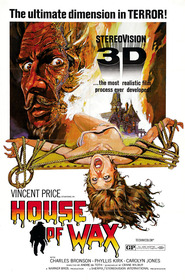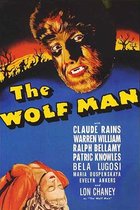Our editor-in-chief Nate Yapp is proud to have contributed to the new book Hidden Horror: A Celebration of 101 Underrated and Overlooked Fright Flicks, edited by Aaron Christensen. Another contributors include Anthony Timpone, B.J. Colangelo, Dave Alexander, Classic-Horror.com's own Robert C. Ring and John W. Bowen. Pick up a copy today from Amazon.com!
House of Wax (1953)
Call it an irrational fear, but wax figures give me the creeps. I recognize the artistic talent behind each of these seemingly lifelike sculptures, but the features have an off-putting radiance that resounds uncannily with me. Thankfully I must not be the only one with unease toward these waxworks given the effectiveness of André De Toth's House of Wax as a horror film. Building off the premise of 1933's Mystery of the Wax Museum, De Toth's remake similarly melds elements of mystery with images of the macabre into a satisfyingly frightful elixir.
The film stars Vincent Price as Professor Henry Jarrod, a brilliant wax figure sculptor whose business partner, Matthew Burke (Roy Roberts) wants their house of wax museum to focus more on the ghoulish than the artistic. After Jarrod refuses to compromise his talents, Burke burns down the museum (with Jarrod inside) and makes off with the insurance money. Some time later, Burke and his fiancée, Cathy (Carolyn Jones) are mysteriously murdered at the hands of a cloaked figure and their bodies are stolen from the morgue. As both the local law enforcement and Cathy's friend Sue (Phyllis Kirk) investigate the happenings, Jarrod resurfaces with a new House of Wax, one that holds a startling secret. Sue soon learns that it's no coincidence that Jarrod's new wax sculpture of Joan of Arc bears a striking resemblance to Cathy. Unfortunately for Sue, Jarrod thinks she'd make a lovely Marie Antoinette.
Price is both fearfully loathsome and brilliantly passionate as Jarrod, and it is this well-rounded performance that operates the moral complexity of House of Wax. At the beginning of the film, we observe Jarrod speaking of his sculptures as if they're human beings; of Marie Antoinette he comments, "People say they can see [her] breathe." In the hands of another actor this might come across as forceful foreshadowing to Jarrod's impending madness, but Price's speech is so impassioned that Jarrod is seen as much as a martyr as the sculptures he surrounds himself with. One could argue that Jarrod is very much the hero of this film. But the brilliance of Price's performance is how well he manages each side of his character. Later on, he is at his most devilish when Jarrod presents Sue with a life-like wax sculpture of her head in an effort to convince her to be his Marie Antoinette. Never have I heard, "Do you like it?" sound more like a threat than an inquiry.
Although Jarrod's sinister actions lend well to House of Wax's more horrifying facets, the film is hardly a straightforward horror picture. Screenwriter Cane Wilbur -- working from the original story by Charles Belden -- crafts a well-balanced whodunit that provides the plot with a touch more substance, preventing it from being too straightforward (a tremendous misstep of the 2005 House of Wax remake, which turned the plot into a slasher picture). Pacing is fluid and quick with the local authorities constantly making strides toward solving the case of the missing bodies while Jarrod, the likely culprit, must evade them at every turn. All this leads to the film's final twist, which is simple, shocking, and effective.
Also effective is De Toth's use of lingering shots on the wax figures themselves, providing his film with a few truly disturbing images. The most memorable images arise during the film's opening moments as the wax figures are melting in the museum fire and De Toth captures the horror with some perturbing close-ups. Eyes fall out of their sockets, faces melt off, and heads come crashing to the ground all under De Toth's fixated camera. Later on in the film his camera focuses tightly on the pristine face of a wax sculpture after two detectives have passed it, noting that it looks an awful lot like a recently diseased missing person. By focusing on the face of the sculpture immediately after the detective's observations, De Toth is forcing his audience to behold the possibility that this sculpture is that missing person... or just a well-made lifelike sculpture.
From the performance of Price to the director's keen eye for the macabre, House of Wax manages to overcome its most glaring drawback: its supporting characters. Although I'm steadfast in my decision to declare Jarrod as the film's star, Sue is given the most screen time, which is an unfortunate misstep in the film. Sue acts as a dutiful protagonist, but her motivation is severely underwhelming. She's too far removed from the plot to matter to the audience; she is, after all, the friend of the fiancé of the man that tried to kill Jarrod. Would it have butchered Wilbur's screenplay to bump Sue up to Cathy's sister rather than just a roommate? Furthermore, when Sue's boyfriend gets caught up in being Jarrod's new apprentice, the plot becomes less about Jarrod's initial revenge and more about these two far removed characters.
Not so detrimental though nevertheless distracting is the film's midpoint "intermission" sequence. This break not only comes at an unwelcome time-Jarrod revealing his former partner Burke's lifeless body-but it's completely unnecessary considering the 88-minute runtime of the film. Once the film returns from intermission we're faced with another distraction: the 3D. Yes, House of Wax was filmed in 3D, though ironically De Toth was blind in one eye and could not see the effects. Nevertheless, the infamous paddleball sequence following the intermission is tossed in to make use of the technology that would start a 1950s craze, but much like the intermission, it's distracting and unwelcome.
I'm not afraid to admit that House of Wax scared me. It didn't scare me in the sense that I wanted to turn on all the lights or I couldn't bear to look at the screen, but it did leave me with quite the collection of disturbing images and thoughts that I'll take with me next time I visit a wax museum. All irrational fears aside, House of Wax is a suspenseful, well-executed horror vehicle for the incomparable Vincent Price that taps into the actor's delightfully eerie presence. Given the cinematic value of remakes and 3D horror films currently, it's good to see that House of Wax has, with all pun intended, been well-preserved.









John, Thanks for the
John,
Thanks for the review of one of the few horror films of note between the 40's and the Creature Features of the 50's.I always thought this was one of Vincent Price's best horror performances. I remember seeing it on a big screen in 3D about 15 years ago and really enjoying it, even the paddleball sequence.
Rich Dishman
These old classics are always
These old classics are always the best, I did not like when they remade this movie but I find that I am saying that all the time now a days. House of Wax simply put was a great movie.
Horror Stories